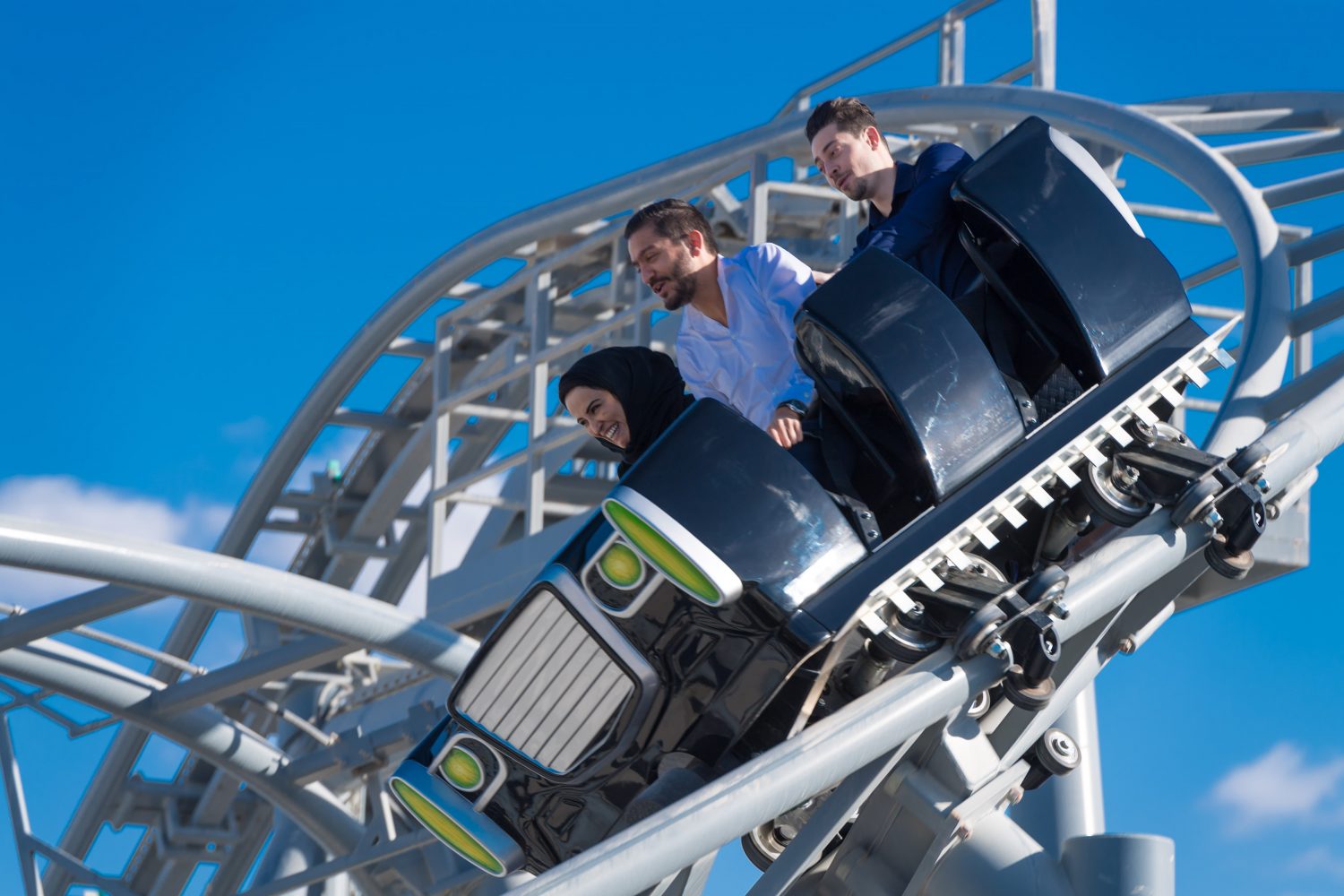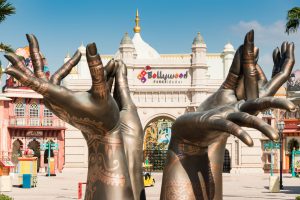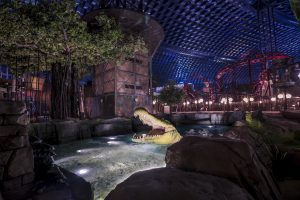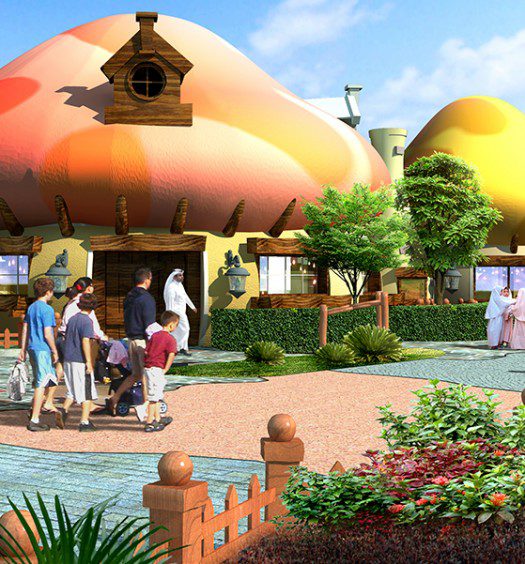The Middle East remains one of the most energetic markets in the world for attractions and entertainment. While the focus has, for a long time, been on the UAE – with Dubai and Abu Dhabi claiming much of the attention – the tide is beginning to turn, with pockets of opportunity emerging elsewhere in the MENA region.
While Abu Dhabi appears to be holding its own, the recent cancellation of the Six Flags theme park in Dubai has added to uncertainty for the country’s theme park market – a case of too much too soon perhaps? InterPark spoke with leading consultants and market players in the region to try and understand what the future holds for the wider market, what role Saudi Arabia has to play and what lessons can be learnt from Dubai
The trouble with Dubai…
International Theme Park Services has been working in the Middle East for over 25 years and provides practical knowledge and hands-on experience to leisure and attendance-driven facilities. For the company’s Dennis Speigel, the market in the Middle East has always been in a state of premature existence.
“A market needs infrastructure such as hotels, highways, retail and so on, as well as residents and an interested tourist market,” he says. “It also needs a pragmatic approach to investment; the days of ‘build it and they will come’ don’t exist today. With the exception of a few parks, the majority continue to labour away, floundering to draw attendance.
“It took Disney 47 years to reach the level of visitors and revenues it enjoys today. The Orlando market evolved at a somewhat furious pace but was able to stay on course to grow to the 73 million tourists it drew in 2018.
“It’s definitely a case of ‘too much, too soon’ in Dubai. There’s not enough of a local market or tourists to support the huge investments being made. It’s a city of 2.8 million, where 80 per cent of the workforce is made up of EPAT labour – many of whom cannot afford to spend much money on entertainment.
“It wasn’t a surprise to me at all that Six Flags has been cancelled; what did surprise me was that it took them so long to announce their withdrawal. I feel it is a ‘shot across the bow,’ indicating that the market is overbuilt and not performing anywhere close to what the hopeful projections were anticipated to be.”
For Speigel, there are definite lessons to be learnt from mistakes made in the UAE. “You only have to look at Dubai to see what a flawed development plan can mean to the balance sheet,” he says. “Markets are built on demand and the actual demand is nowhere close to being what it should be to support these parks. As the proper infrastructure is developed on pace to support attraction developments, then possibly more attractions can be built. At this point though, the market support is not there and neither is the infrastructure or the market visitation.”
For Leisure Development Partners’ senior partner Michael Collins, supply of parks and attractions in Dubai has increased at a very fast rate and while the tourist market has been growing, it still has a way to go in order to get to the level of other multi-park markets around the world.
LDP has extensive experience in ongoing strategy and performance improvement for existing businesses in the market and has advised on numerous types of attraction businesses throughout the UAE since 2000. At present, the company sees that ‘true theme parks’ are concentrated in the UAE with tourists visiting for a variety of reasons – the beach, shopping, the relaxed atmosphere, even the ‘spectacle of it all.’
“Some do come for the visitor attractions,” Collins tells InterPark. “But we believe this is still a secondary driver. Over time, and with great national tourism marketing and individual marketing efforts by parks, there is the potential to further cement the UAE as a visitor attraction and theme park destination. Our ongoing feasibility work in the UAE illustrates the commitment of developers, both private and public, to continue to develop supply and grow demand.
“However, it is also important to consider Abu Dhabi. The markets for the parks associated with both cities entirely overlap. If you compare them with other multiple park markets such as Orlando, California or Paris – the rate of increase in supply has been very rapid. While the choice is great for consumers, the rate of supply increase is aggressive and this has had an impact on certain metrics for the parks.”
With the rapid increase in supply in the UAE, LDP predicted a shift in pricing and yields and this is very much in evidence according to Collins.
“The UAE has always been a premium priced market for attractions with entertainment value,” he says, “exceeding almost all of the other markets globally and aligned with the US destination markets. While lead prices remain high, consumer choice from the increased competition has led to the advent of a discounting culture that was not evident until recently. As a consequence, yields have decreased as predicted.”
Another challenge in creating a global theme park destination in Dubai and Abu Dhabi is the current pricing levels of additional tourist costs such as hotels, car rentals, restaurants and so on, as Yael Coifman, also a senior partner at LDP, explains.
“These additional costs are significantly less in destinations such as Orlando, with multiple packages on offer to families looking to holiday. An adjustment and multiple price points could benefit the further development of theme park tourism to the Emirate.”
While up until recently the focus for theme parks has been concentrated in the UAE, for Philip Taylor, managing director of Team Leisure, things are now changing – albeit early days.
“The driver is diversification away from a petroleum-based economy,” he tells InterPark. “But each country also has unique market factors that are shaping the strategies being followed.”
Team Leisure first entered the Middle East in 2003 to set-up and operate Ski Dubai and has been providing consultation services to the attractions industry there ever since. “In the UAE and Oman, for example, it’s about growing and broadening international tourism,” Taylor says. “In Saudi Arabia it’s about social change, mainly around the domestic market.
“With the Six Flags project in Dubai currently on hold there are definite lessons to be learnt – the biggest being that it takes time to build a successful theme park strategy and that, however we might look at it, four parks opening in the space of six months has proven too much for even a dynamic market such as Dubai to absorb. It makes a huge amount of sense to put the project on hold given the circumstances and my prediction is that everyone else will take heed and adjust their strategies accordingly.
“There is no doubt in my mind though that the theme park market in the Middle East will continue to grow and start to mature in its own unique way. I love the way Abu Dhabi is in parallel to Dubai, growing its cultural offering – the Sheikh Zayed Grand Mosque, the Louvre Abu Dhabi and the recent renewal of its agreement with the British Museum for the Sheikh Zayed National Museum for example. And then there’s Saudi Arabia and Oman – both strong contenders for growth in the region.”
While there have been definite issues in Dubai, for ITEC Entertainment’s president and CEO Bill Coan, it does appear to be an effective primer for countries in the Middle East and other global markets with similar ambitions. ITEC Entertainment has provided creative design and technologies for entertainment projects in the MENA for over 20 years. Its clients range from small independent developers to larger entertainment developers, owners and operators such as Meraas, Dubai Parks and Universal Studios during their exploration with Dubailand.
Adding his thoughts on the recent suspension of the Six Flags project, he told InterPark: “There are a number of factors that influence whether a project gets the green light or not. The learning curve in Dubai has been quite steep and a development pause is natural and healthy. The duration of that pause will depend on market forces, or the initiation of one or more of the formidable projects announced in the region. The key issues for projects of this scale and composition include market weakness impacting the initial business proposition, as well as non-market factors such as the cultural and environmental suitability of the intended guest experience and the alignment of interests between the developer and brand partner. Opportunities will exist for the clever developer that identifies and solves the mistakes of the past with innovative vision and planning.”
Bob Chambers, co-CEO/co-founder of The Producers Group, adds to this, telling InterPark: “The reality is that the developers in Dubai built projects at a very strong pace – perhaps too strong for the number of visitors they have, or will even have in the immediate future. The attendance figures and corresponding financial results indicate insufficient performance to justify the addition of Six Flags into the property. As far as we can tell, international tourism in Dubai is growing – so perhaps the Six Flags park will return… but it’s going to take some time.”
The Producers Group opened an office in Dubai around four years ago. While the company had spent a considerable amount of time travelling there previously, having the office really accelerated its involvement in the region. Today, it regularly works in several GCC and non-GCC countries.
“One lesson to be learnt and something that needs more discussion in the region, is seasonality,” continues Chambers. “In many areas of the UAE and surrounding countries the weather in the summer is oppressive, especially to an international tourist. The idea of operating primarily during the winter months has still not caught on; we need to address the business operating models associated with seasonality, while there are issues relating to the labour market that need addressing as well. Implementing that one change would make a lot of sense to the international visitors and may just increase visitation.”
Based in the UK, dynamic media attractions specialist Simworx is also well qualified to comment on the park and attractions industry in the region, having completed a number of projects in Dubai both at parks and FECs. Sales director Edward Pawley notes: “There has been a significant influx of parks, FECs and other attractions introduced in Dubai over a short period of time, which as we all thought was, as we say, ‘a huge mouth to feed.’ Parks and attractions of this size need to attract large numbers of visitors to continue to operate and reinvest to increase or maintain visitor numbers. It wasn’t a surprise to hear of the cancellation of Six Flags. I don’t think it’s due to the economic climate. It’s about the number of attractions diluting what is the current market and that market not growing fast enough to maintain these attractions.”
And he continued: “Growth, as the market requires, is what needs to be considered. Developers must provide the market with an offering that is collectively appealing to the theme park guest. It must then be allowed to mature into a sustainable tourism market, self-sustaining and expanding as required. But this is nothing new; there are numerous examples of this in our industry.
“However, there will be numerous new opportunities across the whole region in the near future. This is how our industry influences a region over a period of time. New investors will want to offer attractions for locals and in some cases resorts for international visitors.”
Hot off the back of this year’s DEAL show in Dubai, Ruud Koppens, president of Netherlands-based ETF Ride Systems, reports that while there appears to be a slowdown of interest for the larger new rides for theme parks, there was a definite interest in smaller items, including add-ons for existing rides.
ETF has a strong presence in the Middle East theme park sector and takes part in the DEAL show each year, and Koppens added: “So much investment has happened over the past few years that for the moment the market is ‘full.’ As well as this, the low visitor numbers has influenced the parks’ decisions not to invest at this time.
“While we were not involved in the Six Flags project, given its stage of development we were surprised to hear of its cancellation. We feel that once SeaWorld has opened in Abu Dhabi, we will see investment in new theme parks slow down there as well. Having said that, outside of the UAE, Saudi Arabia is a market that will continue to grow over the next twelve months.”
Abu Dhabi – a formidable force
“The story is not over for the UAE market however,” picks up LDP’s Michael Collins. “There are exciting new projects at advanced stages of planning. The existing attractions continue to improve their offering, reinvest and discover better strategies for promotion. While other regions are poised to deliver parks, the UAE has the lead in terms of supply, image and infrastructure and with the right marketing efforts can continue to deliver on its potential.
“While many potential markets in the region have very sparse populations and relatively modest tourism, the UAE has reasonable resident population density and a large tourism market. There are other markets with good potential but all have a long way to go to match the UAE.
“Abu Dhabi continues to grow its already formidable attractions offer in both the cultural and entertainment segments. Ferrari World was the first true theme park in the region and was a clear message of intent. It’s wrong for us to see Abu Dhabi separate to Dubai as it is really making strides in its offering and marketing and will continue to grow from its already relative mature position.”
“Abu Dhabi – and Saudi Arabia – have been carefully taking notes on the amusement park market in Dubai for some time now and both have 2030 masterplans that organise their growth, entertainment, leisure and hospitality plans into carefully paced, thoughtful phased ways,” says Thinkwell’s Craig Hanna. “The UAE is already a strong market for expats and tourists visiting the region.”
Thinkwell has been working in the Middle East since 2003 when it developed the snow play area at Ski Dubai for MAF. Since then, it has completed dozens of projects in the region, ranging from cultural experiences to museums to the world’s largest indoor theme park, Warner Bros. World in Abu Dhabi.
“Moving forward, parks need to consider how their offering works for repeat visitation, as many coming to the parks are locals and want to have something new to do when they return,” continues Hanna. “Growth needs to be thoughtful and strategic, while new markets need to take into consideration their market demand as part of the CAPEX plan.”
Abu Dhabi has already experienced some success with maturing attraction operations, new projects and special events that for ITEC Entertainment’s Bill Coan suggest opportunities for new projects to come on line. But it is Saudi’s grand 2030 vision he feels that represents one of the world’s largest new growth areas in the attractions industry since themed entertainment development is factored into their goals.
“Saudi Arabia’s visionary 2030 plan for major developments in the Kingdom will integrate world class and innovative entertainment venues,” he tells InterPark.
Saudi Arabia – the next big thing?
Crown Prince Mohammad is opening the doors of one of the world’s most conservative societies to a broadening of experiences. His Vision 2030 lays down parameters and targets for the Kingdom to free up many of the more restrictive edicts on the 33 million Saudis. The Saudi General Entertainment Authority says that under Vision 2030 it wants the following growth from theme parks: small 10, large and medium 20 and additionally they plan to establish another five large, five medium and 17 small parks across the kingdom.
In terms of Saudi Arabia’s potential, for Michael Collins it is in a very different position in terms of its attraction development cycle. It has a mature retail market, with most malls having FEC provision, but beyond that, there are only modest amusement parks and museums – no true theme parks as yet.
“The resident market in KSA is relatively large and prosperous when compared with other countries in the region,” he says. “Continued liberalisation and an appetite from the public sector and private developers is on the rise and with a boom in visitor attractions planning and development in Saudi Arabia there is going to be a significant growth phase – even if not all of the projects move forward.”
For Yael Coifman, Saudi Arabia will need to rely primarily on its resident and domestic tourist markets as opposed to the high levels of international tourism in the UAE. “As a result, care to get the pricing correct from the outset should be taken in order to build loyal and repeat visitation from the local population.”
For Bob Chambers, while the outlook for growth in Saudi Arabia looks positive, he tells InterPark he is cautiously optimistic, primarily due to the concentration of funding coming from the sovereign wealth fund and the apparent minimal funding from local investors.
“This adds risk,” he says. “Neighbouring countries don’t seem to be pulling back because of Dubai’s recent failings, but are naturally cautious. The main player in Abu Dhabi, Miral, is moving ahead with its plans and has a solid track record of completing projects, which reduces risk there.”
For Dennis Speigel it is all about pace – there shouldn’t be a race to be the biggest in the market. “The potential visitation is in the queue to support whatever is being planned,” he says. “Saudi Arabia and Abu Dhabi need to make sure they don’t ‘over plan,’ over build or capitalise. Saudi finally realised they needed to jump on the ‘leisure bandwagon’ in a big way as Dubai beat them to it – I’m not saying they did it correctly but they did get there first. Now that Saudi Arabia has come to grips with the fact its oil supply is dwindling and evacuated in the next 25-30 years, they are looking at the global leisure market as a way to inject new life into their country.”
Simworx’s Pawley agrees that the market needs to slow down and take stock in order to survive and grow in the coming years.
“It (the Middle East theme park market) needs to slow down, take a breath and study the mistakes that have been made and as I mentioned before, let the visitor numbers and tourism to the area determine the required investment and capacity,” he says. “In the future, new regions will want a slice of the market, so I see more resorts and attractions being introduced. They should look at some of the mature markets such as Europe. Here parks and resorts have grown over long periods of time. It’s not a matter of build and they will come. The most successful attractions have evolved over a long periods of time, understanding their market, guest expectations and their competition.”
And he also believes, on the subject of cultural differences and how reserved Middle East countries are compared to the US and Europe, that it is too early to say if things are changing in this respect.
“The attractions that have been introduced to the region would operate successfully in any US or European market. Survival and guest numbers will give us a clear indication if this was the right approach. I hope we are right and we see reinvestment in these attractions which is good for the whole industry. I always take the approach that you must first understand your guest expectations and then secondly, educate your guest over a period of time.
“The introduction of new attractions and expansion at a sustainable level that will give the guest an enjoyable day out and result in them visiting the attraction year after year is also vital. I’ve seen numerous examples of emerging markets where new attractions are busy but the queue lines are empty and the viewing areas are packed with onlookers. If this is what we see in this or any region, a new approach is required and it will take time to educate the guest to visit attractions and want to participate in riding a roller coaster or dark ride and then want to return every year to ride it again! But that’s what this great industry is all about isn’t it?”
Lessons to be learnt…
“We have seen over and over that bigger isn’t always better – you have to ask the question, ‘what is enough to enter a new market and build it correctly,” continues Speigel. “Phase a master planning process to meet the market growth, don’t overbuild, build based on demand. The UAE faces many challenges – population to support a mega park system, the weather and enough tourists that really want to go to the Middle East for recreation outside in 100 degree heat! It has always seemed to us that the UAE is a shopping Mecca with that being first on visitors’ minds.
“The Middle East needs to pace itself and support the projects with necessary infrastructure – don’t over capitalise, which really is the kiss of death. When this is done, none of the supporting programmes necessary to foster a healthy park can be done. When a park is over capitalised it puts itself in a position of cost cutting, which can destroy a park’s popularity.”
For Michael Collins while all markets offer potential for visitor attractions, the key is to take a realistic view on the scale of development, which will create a viable business. “This is a key part of the feasibility process,” he says. “There are LDP projects under construction in Oman and Qatar that are scaled to these markets. Not every market can support a full-scale theme park, but every market can support the right sized visitor attraction. There are still markets with untapped potential, such as Jordan, Egypt and Morocco, which have solid residential markets and growing tourism markets.”
To move forward, for LDP, developers in the Middle East considering new projects need to do their homework with industry specialists first and foremost. “Realistic feasibility relies on tried and tested analysis driven by real industry benchmarking,” says Collins. “Build it and they will come rarely works – instead, scale to the market, understand the competition both as it stands and what is being developed. For existing businesses, realism regarding pricing and strong marketing is a must. For many existing parks there is potential attendance upside if they can tap into the potential of their tourist markets.”
Yael Coifman adds to this, telling InterPark: “Joint marketing efforts of the destinations should really be explored. Abu Dhabi and Dubai could market together, but the region as a whole could do so as well.”
Alongside this, for Coifman, creating park ticket and accommodation packages implemented at the likes of Universal and Disney, could help make these Middle East destinations more ‘affordable’ for families wanting to go on a theme park holiday.
“Constantly reinvesting in the parks and ensuring they offer continued quality in the experience will also be key in retaining repeat visitors from residential markets during the years to come,” she says.
For Taylor, emerging markets in the Middle East can learn from the mistakes made in Dubai. While the new theme parks in Dubai are struggling to gain traction, he tells InterPark, it needs to be remembered that they are just one aspect of a very broad strategy that’s seeing an amazing array of different attractions and destination developments opening across the whole spectrum.
“The rest of the Middle East tends to still be in the ‘shopping mall attractions’ phase of development,” he says. “In the UAE, however, we’re seeing a wider range of secondary stand-alone attractions opening, especially in the activity sector – both indoor and outdoor.
“The theme park market in the Middle East needs to keep its nerve moving forward. I would say, however, that there is a growing question mark over whether the western model of a theme park is the right solution for the area. The success of Global Village Dubai – now in its 23rd season – in attracting over six million visitors and all the other KPIs that go with this in its 158 day-long 2017/18 season, teaches us that given time, and with persistent and prudent management, the Middle East can and will need to develop its own unique theme park model to succeed.”
One view is that the theme park market in the Middle East will grow when the tourism message to their audience becomes synergised. “We have noticed that they are just starting to get an orchestrated message to Chinese tour operators for instance,” says Bill Coan, “and that is paying off – visitor numbers have increased from that sector.
“The same could be true for northern Europeans who would seek a warm respite during their cold winters – visit Dubai to play golf and have fun in the sun. This approach we are yet to see. Growing each market will help them achieve their international visitation goals in the long run.”
ETF’s Ruud Koppens adds to this, telling InterPark: “While I don’t see that the Middle East will become a tourist destination such as Florida, it should invest in making foreign guests aware that this region has a lot to offer in this respect. I feel this is not well-known around the world at present and coupled with the pleasant winter climate, could surely have a positive effect attracting more guests to visit the region each year.”
Pockets of opportunity
There are also some ‘surprise’ pockets of opportunity elsewhere in the Middle East, including Egypt’s New Cairo plan, which is promising a theme park four times the size of Disneyland, and for Coan, Oman is a wonderful place with ambitions to leverage its natural environment, history and hospitable culture to enhance destination tourism to the country.
“Looking ahead, growth will certainly happen in the Middle East but it is difficult to look at it as a singular entity because of the diversity of projects, different local and regional interests and the competitive nature of the various countries,” he tells InterPark. “The sustainability of current and future projects will also become increasingly challenging. Issues such as content diversity, balance among available and planned attractions within individual cities and regions and the qualifications and experience of management teams, the supporting professionals working on new projects, will all become increasingly critical to the industry’s future.”




















